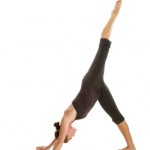Many thanks to: aurawellnesscenter.com.
By Jenny Park
Let’s cut to the chase. Do not lock your joints! Some teachers are telling their students to lock the knees or elbows in certain asanas especially balancing asanas. These yoga teachers have no understanding of biomechanics or anatomy. Talk to any doctor or physical therapist and you will learn there are no rewards for locking joints (hyperextending), but there are definite risks. Furthermore, it doesn’t matter, which Guru or master says to lock the knees. It would be wise to leave class, because you only have one set of knees.
Why You Should Not Lock Joints
Why do drill sergeants, personal trainers, and yoga instructors say: Do not lock your joints!” More than any other joints, the knees seem to take the most abuse from locking. Afterall, we don’t always walk on our hands. Therefore, it has been said a million times over and over again to avoid locking your knees. However, when you start to get into the habit of locking joints it causes long-term health problems.
Chain of Events
When you lock the knees while practicing yoga poses, you are hyperextending your joints. Ultimately, this will set you up for future injuries. When you are locking your knees during poses you are putting strain on your ligaments. By putting extra strain on your ligaments they will begin to wear down a lot faster. You are also putting strain on your cartilage and connective tissues as well.
Communication Skills
Sometimes, during different types of yoga classes, the yoga instructor will tell the students to lock their knee. This is a misunderstanding of information regarding anatomy. Nevertheless, a yoga instructor who does not understand anatomy or how to communicate is one to be avoided. Supposedly, they claim to actually mean to “draw the knee up” to tighten muscles of the leg. If you draw up without locking, this gives the muscles around the knee great support. However, your knees should always remain slightly bent to avoid any issues. In the long run, it can take some practice to get this technique right.
Domino Effect
Do not lock your joints, because once a joint is damaged it starts to cause damage throughout the body. After an injury, your body wants to avoid pain. You will not want your injured joint to move into pain. Consequently, this is why people and animals limp when injuring a joint. This results in a locked joint or a joint that is out of balance. The results are much like a domino effect. Once one joint goes wrong, they all start to follow. The body works simultaneously and should be taken care of as a whole. To avoid locking your joints is very important to practice, when you are participating in classes. Sometimes, a joint injury can lead to issues such as osteoarthritis.
Safe and Healthy Movement
It is very important to keep yourself moving. In fact, movement is keep your joints active and strong. On the positive side, yoga is designed to make sure that you avoid any physical problems. As a matter of fact, yoga was created to help the body and mind. Practicing in the correct manner should not lead to any joint issues.
Myths vs. Long-Term Results
Unfortunately, joint locking is a training method used by trainers in martial arts. The idea is that joint locking will make you punch or kick harder. However, this theory is not proven and there is much debate about short-term results. In fact, we clearly know that joint locking can lead to long-term damage to the joints. If this happens, it can be very difficult to recover. Sometimes, joint damage haunts us for life. So, if you are considering joint locking as a training method in yoga, please be aware of the serious risks involved.
Awareness
Teachers should always let it be known to avoid locking your knees or elbows. Equally important: Stay in touch with your body. When you are practicing yoga, you want to be aware. You must be sure to be conscious of what you are doing. Unfortunately, some students are not focused during practice. As a result, something that may not seem like a problem today comes to life in the future. It is important to realize, that joint injury problems can slowly come back. Specifically, joint problems today often become discomforting health issues in the future. For your own health: Do not lock your joints!
© Copyright – Aura Wellness Center – Publications Division
Do you want to become a mindfulness meditation teacher?
See our selection of Yoga instructor courses and continuing education courses, please visit the following link.
https://aurawellnesscenter.com/store/
Click here to see our online Yoga Nidra teacher training course.
Are you an experienced teacher looking for YACEP credits or continuing education?
Subscribe to Our Newsletter for Special Discounts and New Products
Are you considering how to become a yoga instructor? See our selection of affordable meditation and yoga teacher certification courses.
Related Resources:
by Leslie Kaminoff and Amy Matthews
52 Essential Principles of Yoga Philosophy to Deepen your Practice
by Rina Jakubowicz.
A Relaxing Way to De-stress, Re-energize, and Find Balance
by: Gail Boorstein Grossman.
YOGA: THE PATH TO HOLISTIC HEALTH
by B.K.S. Iyengar
TEACHING YOGA: Essential Foundations and Techniques
By Mark Stephens
Do you want to become a yoga instructor? See our selection of affordable meditation and yoga teacher certification courses.


